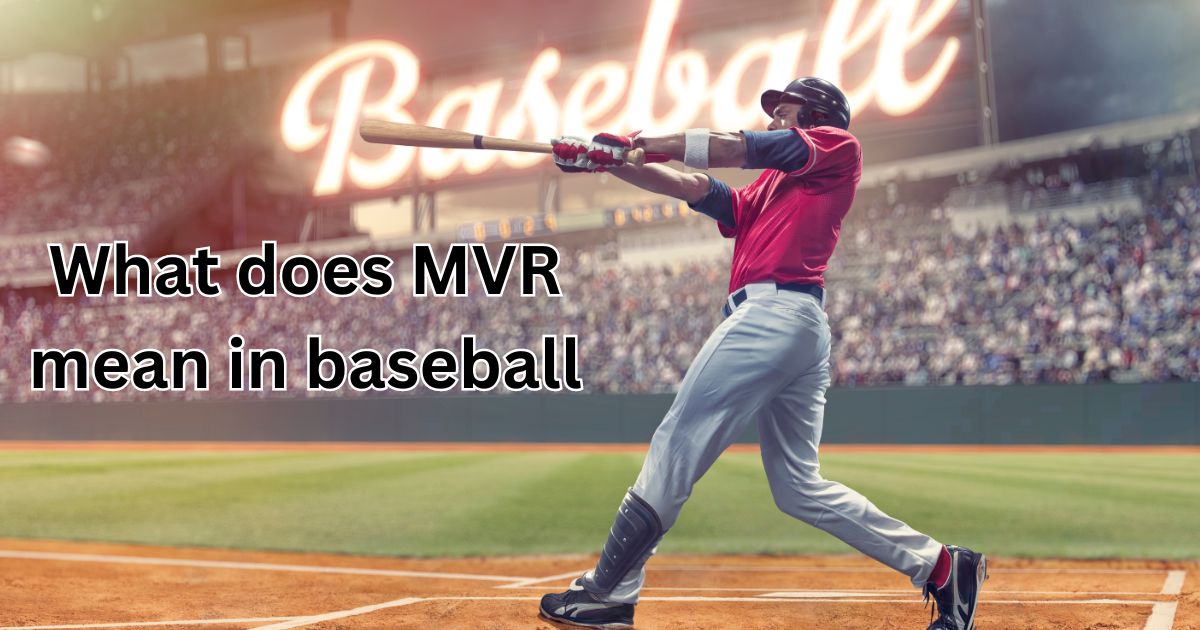Baseball is a sport rich in history and tradition, and it has its own set of terms that can be confusing to the uninitiated. One of the newer and less familiar terms is “MVR.” If you’ve ever found yourself wondering, What does MVR mean in baseball? you’re not alone. MVR stands for “Mound Visits Remaining,” and it plays a crucial role in the strategy and pace of the game. This article will explore the meaning, significance, and implications of MVR in baseball, offering a detailed analysis that is both informative and engaging.
The Origins of MVR in Baseball
The concept of MVR was introduced relatively recently as part of Major League Baseball’s (MLB) efforts to speed up the game and enhance the overall fan experience. Historically, managers and coaches could visit the pitcher’s mound as many times as they wished during a game. However, these mound visits often contributed to lengthy game times, which led to growing concerns among fans and league officials.
To address this issue, MLB introduced a rule in 2018 limiting the number of mound visits to six per team per game. This rule change aimed to reduce unnecessary delays and maintain the flow of the game. The introduction of MVR was a significant shift in baseball strategy, requiring managers to be more judicious with their mound visits. The rule has since become an integral part of the game, influencing how teams manage their pitching staff and approach late-game situations.
Defining MVR: What Does MVR Mean in Baseball?
So, what does MVR mean in baseball? MVR, or Mound Visits Remaining, refers to the number of mound visits a team has left during a game. These visits include trips by the manager, coaches, or other players to the pitcher’s mound for any reason, except for certain exceptions such as injury checks or substitution calls. Once a team exhausts its allotted mound visits, any further visits could result in the removal of the pitcher from the game, adding a strategic layer to the decision-making process.
Understanding MVR is essential for grasping the nuances of baseball strategy. Mound visits are often used to calm a rattled pitcher, discuss strategy, or simply buy time while a reliever warms up in the bullpen. With the introduction of the MVR rule, these visits must now be used more sparingly and thoughtfully, as they have a direct impact on the game’s outcome.
Why MVR is Important in Modern Baseball
MVR has become an important metric in modern baseball for several reasons. First, it directly influences the pace of the game. By limiting the number of mound visits, MLB has successfully reduced the length of games, making them more appealing to a broader audience. This change is part of a larger effort by the league to modernize the sport and make it more accessible to younger fans who may not have the patience for games that drag on for hours.
Moreover, MVR adds a strategic element to the game that wasn’t as prominent before. Managers now have to be more tactical about when to use their mound visits. For instance, they must decide whether to use a visit early in the game to address a minor issue or save them for critical late-game situations. This added layer of strategy makes the game more complex and interesting, both for players and fans.
How MVR is Calculated
Calculating MVR is straightforward, but understanding how it impacts the game requires a deeper dive. At the start of each game, both teams are allotted six mound visits. This count is displayed prominently on scoreboards in MLB stadiums and is tracked diligently by the official scorekeeper. Each time a manager, coach, or player visits the mound, the number of MVR decreases by one.
However, there are exceptions to this rule. For example, a visit to check on an injured player or to make a pitching change does not count against the MVR. Once the mound visits are exhausted, the team cannot make another visit without risking the removal of the pitcher. This rule forces teams to use their visits wisely, often saving them for high-pressure situations late in the game when a crucial decision or pep talk could make all the difference.
The Role of MVR in Pitcher-Batter Matchups
MVR plays a crucial role in pitcher-batter matchups, particularly in high-stakes situations. A well-timed mound visit can give a pitcher the confidence boost needed to get out of a jam or provide crucial strategic advice on how to approach a tough batter. For example, a visit might be used to remind the pitcher of the scouting report on a particular hitter, suggesting specific pitch types or locations that could exploit the batter’s weaknesses.
On the flip side, batters are also aware of the MVR count and may use this to their advantage. If a team is low on mound visits, a batter might try to work the count or foul off pitches to force the opposing manager’s hand, knowing that a visit might deplete the team’s MVR and leave the pitcher to fend for themselves later in the game. This cat-and-mouse game adds an intriguing dynamic to each at-bat, with both sides trying to outmaneuver the other.
MVR vs. Traditional Baseball Metrics
When comparing MVR to traditional baseball metrics like Earned Run Average (ERA) or Walks plus Hits per Inning Pitched (WHIP), it becomes clear that MVR serves a different purpose. While traditional metrics focus on quantifying a player’s performance, MVR is more about game management and strategy. It doesn’t measure a player’s skill but rather how a team manages its resources during a game.
This distinction is important because it highlights the multifaceted nature of baseball. While stats like ERA and WHIP are invaluable for evaluating a player’s abilities, MVR provides insight into a team’s strategic approach. It reflects how well a manager understands the flow of the game, the psychological aspects of pitching, and the importance of timing in baseball. In this way, MVR complements traditional metrics, offering a more holistic view of how games are won and lost.
Also Read: Mom Life FamousParenting
MVR and Game Situations
MVR often comes into play during critical game situations, such as when a pitcher is struggling, or the opposing team is mounting a rally. In these moments, a mound visit can serve multiple purposes: calming the pitcher, discussing strategy, or simply buying time for a reliever to warm up. However, with a limited number of visits available, managers must be judicious in their use, often saving them for the most crucial moments.
For instance, a manager might opt to use a visit in the ninth inning with runners in scoring position, knowing that a well-timed word of encouragement or strategic advice could be the difference between a win and a loss. Conversely, using too many visits early in the game can leave a team vulnerable in later innings when the stakes are higher, and the margin for error is smaller. This strategic balancing act is a key aspect of modern baseball and one that MVR has brought to the forefront.
MVR in Professional Baseball Leagues
While MVR is most commonly associated with Major League Baseball, its principles are also being adopted by other professional baseball leagues around the world. For example, Nippon Professional Baseball (NPB) in Japan and the Korean Baseball Organization (KBO) have begun to implement similar rules to manage game pace and mound visits.
In these leagues, the introduction of MVR has been met with varying levels of acceptance, but the overall trend is toward embracing the concept. As the globalization of baseball continues, it’s likely that MVR or similar metrics will become a standard part of the game worldwide, influencing how baseball is played and watched in different cultures and regions.
MVR’s Influence on Player Development
MVR doesn’t just impact in-game strategy; it also plays a role in player development, particularly for pitchers. In the minor leagues, where player development is the primary focus, coaches use MVR to teach young pitchers how to manage the psychological aspects of the game. Learning to perform under pressure, knowing when to ask for help, and understanding the strategic use of mound visits are all crucial skills that are honed in the minor leagues.
Moreover, MVR helps young players develop a sense of autonomy on the mound. With fewer mound visits available, pitchers are encouraged to take more responsibility for their own performance, learning to adjust on the fly without relying on frequent input from coaches. This self-reliance is a valuable trait that can help pitchers succeed at higher levels of competition.
MVR and Sabermetrics
Sabermetrics, the advanced statistical analysis that has revolutionized baseball, has also incorporated MVR into its repertoire. Analysts use MVR data to study trends and patterns, such as how often teams use their mound visits and how these visits correlate with game outcomes. By examining this data, teams can gain insights into how to optimize their use of MVR, potentially giving them a competitive edge.
For example, sabermetricians might analyze the success rates of pitchers before and after mound visits, looking for correlations between visit frequency and performance. This data can then be used to inform in-game decisions, such as determining the ideal number of visits to maximize a pitcher’s effectiveness or identifying the most opportune moments for a visit based on historical trends.
Controversies Surrounding MVR
Like any significant rule change in sports, the introduction of MVR has not been without controversy. Critics argue that the rule overly restricts managers and can sometimes lead to unintended consequences, such as a pitcher being left on the mound too long because the team has exhausted its visits. Others believe that the rule disrupts the natural flow of the game, forcing managers to focus too much on visit management rather than the nuances of in-game strategy.
On the other hand, proponents of the rule argue that it has succeeded in its primary goal of speeding up the game and making it more fan-friendly. They also point out that the rule adds a new layer of strategy to the game, challenging managers to be more creative and resourceful. While the debate over MVR continues, its impact on the game is undeniable, and it remains a topic of discussion among players, coaches, and fans alike.
MVR in the Media
Media coverage of MVR has grown since its introduction, with sports commentators and analysts frequently discussing its impact on games. Whether it’s a crucial mound visit in the ninth inning or a discussion about how a team is managing its visits, MVR has become a regular part of baseball broadcasts and analysis.
Commentators often use MVR to explain the decisions made by managers, providing viewers with a deeper understanding of the game. This media attention has helped to popularize the term and educate fans about its significance. As MVR continues to play a key role in baseball strategy, it’s likely that its presence in the media will only increase, making it a staple of baseball discourse.
The Future of MVR in Baseball
Looking ahead, the future of MVR in baseball appears to be secure, with potential adjustments on the horizon as the game continues to evolve. One area of focus could be refining the rules around what constitutes a mound visit, possibly allowing for more flexibility in certain situations. Additionally, advancements in technology could lead to new ways of monitoring and analyzing MVR, providing teams with even more data to inform their decisions.
As baseball embraces technology and data analytics, MVR is likely to become even more integrated into the strategic fabric of the game. This evolution could see MVR playing a role not just in managing game pace but also in enhancing player performance and team strategy. Whatever the future holds, MVR will undoubtedly remain a key component of baseball’s ongoing development.
Fan Perspectives on MVR
Fans have had mixed reactions to the introduction of MVR, with opinions often divided along generational lines. Older fans, who are accustomed to the slower pace of traditional baseball, sometimes view MVR as an unnecessary change that disrupts the rhythm of the game. They argue that the frequent mound visits of the past were part of baseball’s charm and strategy.
Conversely, younger fans and those new to the sport tend to appreciate the rule, as it helps to keep games moving and makes them more engaging. For these fans, MVR represents a modernization of the sport that aligns with their expectations for a faster-paced, more dynamic experience. As the baseball fanbase continues to evolve, so too will perceptions of MVR, with its acceptance likely growing over time.
Coaches and Managers: Using MVR to Gain an Edge
For coaches and managers, MVR is both a challenge and an opportunity. The limited number of mound visits forces them to think strategically about when and how to use these visits to gain an advantage. Some managers excel at this, using their visits to defuse tense situations, provide critical advice, or simply give their pitchers a moment to collect themselves.
Others may struggle with the rule, either using their visits too early or failing to use them effectively in crucial moments. The ability to manage MVR effectively has become a hallmark of successful managers, and those who master this aspect of the game can often find themselves with a competitive edge. As teams continue to adapt to the rule, MVR management is likely to become an even more important skill for managers at all levels of the game.
Case Studies: Famous MVR Moments in Baseball History
Throughout baseball history, there have been several notable instances where MVR played a crucial role in the outcome of a game. These moments serve as case studies in how MVR can influence strategy and decision-making. For example, in a close playoff game, a well-timed mound visit might have helped a team escape a bases-loaded jam, preserving a narrow lead and ultimately securing the victory.
Conversely, there have been instances where a team ran out of mound visits, forcing the manager to leave a struggling pitcher on the mound, leading to a game-changing hit. These case studies highlight the importance of MVR in modern baseball and provide valuable lessons for managers and players alike.
MVR and Baseball Analytics Software
In the era of advanced analytics, MVR has found its way into baseball software tools that teams use to track and analyze player performance. These tools allow managers to monitor their mound visit usage in real time, helping them make informed decisions about when to use their visits. Additionally, software can analyze historical data to provide insights into how MVR has been used in the past and how it might be optimized in future games.
Popular analytics platforms like Statcast and Baseball Savant include MVR data as part of their comprehensive analysis of games, giving teams access to a wealth of information that can inform their strategy. As these tools continue to evolve, the integration of MVR data will likely become even more sophisticated, offering teams new ways to gain an edge on their opponents.
Learning MVR: Resources for Coaches and Players
For those looking to deepen their understanding of MVR, there are several resources available that provide valuable insights and guidance. Books and articles on baseball strategy often include sections on MVR, explaining how it can be used effectively in different game situations. Online courses and workshops for coaches also cover MVR, offering practical tips on how to manage visits and integrate MVR into broader game strategies.
Additionally, many baseball analytics websites and blogs feature discussions and analysis of MVR, providing a wealth of information for those interested in the topic. By taking advantage of these resources, coaches, players, and even fans can gain a deeper appreciation for the role of MVR in modern baseball and learn how to leverage it to their advantage.
Conclusion
In conclusion, What Does MVR Mean in Baseball? MVR, or Mound Visits Remaining, is a relatively new but significant aspect of modern baseball. It adds a strategic layer to the game, influencing how teams manage their pitching staff and approach crucial moments. Understanding MVR is essential for anyone looking to gain a deeper appreciation for baseball’s complexities, as it reflects the evolving nature of the sport and its ongoing efforts to balance tradition with innovation.
As baseball continues to evolve, MVR will undoubtedly remain a key part of the game, shaping how managers strategize, how players perform under pressure, and how fans experience the sport. By mastering the intricacies of MVR, teams can gain a competitive edge, making it a vital tool in the modern baseball landscape. Whether you’re a player, coach, or fan, understanding what MVR means in baseball will enhance your enjoyment and understanding of the game, offering a new perspective on the strategies that define America’s pastime.










